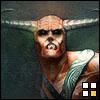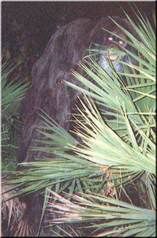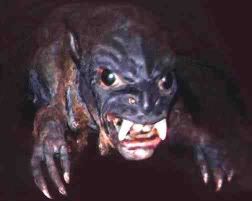| Topic: DRAGONS UNICORNS MERMAIDS PEGASUS OTHER MYTHIC ANIMALS | |
|---|---|
|
Okay I will call you a nice teddy bear.
  Honey Bunny Jeff, actually I like Honey Bunny better and teddy bear would be the second name Honey Bunny Jeff, actually I like Honey Bunny better and teddy bear would be the second name
|
|
|
|
|
|
The Wendigo
While this creature is considered by many to be the creation of horror writer Algernon Blackwood in his classic terror tale, "The Wendigo", this woods spirit was, and is, very real to many in the northern woods and prairies of the state. Many legends and stories have circulated over the years about a mysterious creature who was encountered by hunters and campers in the shadowy forests of the upper regions of Minnesota. In one variation of the story, the creature could only be seen if it faced the witness head-on, because it was so thin that it could not be seen from the side. The spirit was said to have a voracious appetite for human flesh and the many forest dwellers who disappeared over the years were said to be victims of the monster. The American Indians had their own tales of the Wendigo, dating back so many years that most who were interviewed could not remember when the story had not been told. The Inuit Indians of the region called the creature by various names, including Wendigo, Witigo, Witiko and Wee-Tee-Go but each of them was roughly translated to mean "the evil spirit that devours mankind". Around 1860, a German explorer translated Wendigo to mean "cannibal" among the tribes along the Great Lakes. Native American versions of the creature spoke of a gigantic spirit, over fifteen feet tall, that had once been human but had been transformed into a creature by the use of magic. Though all of the descriptions of the creature vary slightly, the Wendigo is generally said to have glowing eyes, long yellowed fangs and overly long tongues. Most have a sallow, yellowish skin but others are said to be matted with hair. They are tall and lanky and are driven by a horrible hunger. But how would a person grow to become one of this strange creatures? According to the lore, the Wendigo is created whenever a human resorts to cannibalism to survive. In years past, such a practice was possible, although still rare, as many of the tribes and settlers in the region were cut off by the bitter snows and ice of the north woods. Unfortunately, eating another person to survive was sometimes resorted to and thus, the legend of the Wendigo was created. But how real were (or are) these creatures? Could the legend of the Wendigo have been created merely as a "warning" against cannibalism? Or could sightings of Bigfoot-type creatures have created the stories. While this is unknown, it is believed that white settlers to the region took the stories seriously. At times, they even took the sightings and reports quite seriously and made it enough of the local culture that stories like those of Algernon Blackwood were penned. Real-life stories were told as well and according to the settlers' version of the legend, the Wendigo would often be seen (banshee-like) to signal a death in the community. A Wendigo allegedly made a number of appearances near a town called Rosesu in Northern Minnesota from the late 1800's through the 1920's. Each time that it was reported, an unexpected death followed and finally, it was seen no more. More: http://www.prairieghosts.com/wendigo.html 
|
|
|
|
|
|
Okay I will call you a nice teddy bear.   Honey Bunny Jeff, actually I like Honey Bunny better and teddy bear would be the second name Honey Bunny Jeff, actually I like Honey Bunny better and teddy bear would be the second name
   
|
|
|
|
|
|
The Wendigo While this creature is considered by many to be the creation of horror writer Algernon Blackwood in his classic terror tale, "The Wendigo", this woods spirit was, and is, very real to many in the northern woods and prairies of the state. Many legends and stories have circulated over the years about a mysterious creature who was encountered by hunters and campers in the shadowy forests of the upper regions of Minnesota. In one variation of the story, the creature could only be seen if it faced the witness head-on, because it was so thin that it could not be seen from the side. The spirit was said to have a voracious appetite for human flesh and the many forest dwellers who disappeared over the years were said to be victims of the monster. The American Indians had their own tales of the Wendigo, dating back so many years that most who were interviewed could not remember when the story had not been told. The Inuit Indians of the region called the creature by various names, including Wendigo, Witigo, Witiko and Wee-Tee-Go but each of them was roughly translated to mean "the evil spirit that devours mankind". Around 1860, a German explorer translated Wendigo to mean "cannibal" among the tribes along the Great Lakes. Native American versions of the creature spoke of a gigantic spirit, over fifteen feet tall, that had once been human but had been transformed into a creature by the use of magic. Though all of the descriptions of the creature vary slightly, the Wendigo is generally said to have glowing eyes, long yellowed fangs and overly long tongues. Most have a sallow, yellowish skin but others are said to be matted with hair. They are tall and lanky and are driven by a horrible hunger. But how would a person grow to become one of this strange creatures? According to the lore, the Wendigo is created whenever a human resorts to cannibalism to survive. In years past, such a practice was possible, although still rare, as many of the tribes and settlers in the region were cut off by the bitter snows and ice of the north woods. Unfortunately, eating another person to survive was sometimes resorted to and thus, the legend of the Wendigo was created. But how real were (or are) these creatures? Could the legend of the Wendigo have been created merely as a "warning" against cannibalism? Or could sightings of Bigfoot-type creatures have created the stories. While this is unknown, it is believed that white settlers to the region took the stories seriously. At times, they even took the sightings and reports quite seriously and made it enough of the local culture that stories like those of Algernon Blackwood were penned. Real-life stories were told as well and according to the settlers' version of the legend, the Wendigo would often be seen (banshee-like) to signal a death in the community. A Wendigo allegedly made a number of appearances near a town called Rosesu in Northern Minnesota from the late 1800's through the 1920's. Each time that it was reported, an unexpected death followed and finally, it was seen no more. More: http://www.prairieghosts.com/wendigo.html 
This looks like something I saw on another site, but it was called something else. Have to see if I can find it again. |
|
|
|
|

|
|
|
|
|

The Skunk Ape or Florida Skunk Ape is a hominid cryptid said to inhabit the Southeastern United States,from places such as Oklahoma, North Carolina, Arkansas, and Illinois, although reports from the Florida Everglades are particularly common. It is named for its appearance and for the unpleasant odor that is said to accompany it. According to the United States National Park Service, the skunk ape exists only as a local myth. Reports of the Skunk ape were common in the 1960s and 1970s. Particular cases of sightings of skunk apes include "Knobby" and the "Fouke Monster". The Skunk Ape is said to be a large hairy, bipedal mammal that calls the Florida Everglades home. They have (allegedly) been spotted as far north as Tallahassee and as far south as Lostman's River. Large adult males are said to weigh in excess of 450 lbs and stand 6 to 7 feet tall with reddish or dark brown hair similar in appearance to an orangutan or gorilla. Some believe that this biped is part of the same species as the famed Big Foot. A handful of sightings have also happened in the Western US, including Simi Valley, CA. In recent months, several sightings have been reported near the Withlacoochee River in Brooks County, GA, between Quitman and Valdosta. The smell of a Skunk Ape has been reported to be similar to rotten eggs or Hydrogen Sulfide. Purported photos of a skunk ape were taken by a Florida woman claiming to have photographed the creature in the palmettos at the edge of her backyard. The photographer claimed that for three nights the ape had entered her yard to take apples from a bushel basket on her porch. She was convinced it was an escaped orangutan. The police were called to the house continuous times but when they arrived the 'Ape' was gone. The pictures have become known to Bigfoot enthusiasts as the "Myakka skunk ape photos". Loren Coleman is the primary researcher on the Myakka photographs, having tracked down the two photographs to an "Eckerd photo lab at the intersection of Fruitville and Tuttle Roads" in Sarasota County, Florida. |
|
|
|
|
|
Edited by
tazzops
on
Fri 08/12/11 06:24 AM
|
|

Chupacabra -- which means "goat sucker" -- got it's name from the first reports of mutilated goats. In September 1995 Madeleine Tolentino and other eyewitnesses claimed to have seen a creature "three or four feet tall, with skin like that of a dinosaur, it had bright eyes the size of hens eggs, long fangs and multicolored spikes down its head and back.? Other eyewitnesses have also said that it looks part bat, part kangaroo, and part alien Grey. Another eyewitness sad "...it's height was about four feet tall with a large head, a lip-less mouth, fangs and lid-less red eyes... ...it's body was small and it had scrawny clawed arms and webbed bat wings and muscular hind legs that appeared to be for leaping." The predatory habits of the Chupacabra have always been directed toward livestock such as chickens, rabbits, goats and other small animals. It kills its prey by draining all the animal's blood from its body, through a single hole. To date no humans have been killed by this creature even though many have attempted to trap the creature over the years. The majority of the sightings have taken place in Puerto Rico, but it has also been seen in Florida, Mexico, New Mexico, and Texas. |
|
|
|
|
|
Edited by
tazzops
on
Fri 08/12/11 06:31 AM
|
|

The Dover Demon was first sighted at night by three seventeen-year-olds who were driving through the Dover area when the car's headlights illuminated it. Bill Bartlett, the driver, reported that he saw what he thought at first was a dog or a cat, but upon closer inspection realized that it was a bizarre, unearthly-looking creature crawling along a stone wall on Farm Street. Bartlett continued to watch the creature, and he reported it to have a disproportionately large, watermelon-shaped head and illuminated orange eyes, like glass marbles. It had long, thin arms and legs with slender fingers, which it used to grasp onto the pavement. It was hairless and had rough, flesh-toned skin, described as tan and sandpaper-like. The creature's appearance was very plain, with no nose or ears, and no mouth was seen. The witness drawings portray its head as having a skull shape, forming the contour of a circle on top with a more elliptical ending projecting down to include where the nose and mouth would be. The creature was sighted an hour later, by John Baxter, 15, as he was walking home. He said it was bipedal and ended up running into a gully and standing next to a tree. The next day, Abby Brabham, 15, and Will Traintor, 18, claimed to have seen a similar looking creature from Traintor's car, on the side of the road. Brabham's description matched Bartlett's and Baxter's descriptions, except this time the cryptid had illuminated green eyes. She approximated its height as "about the size of a goat". Investigators attempted to shake up Ms. Brabham by noting she said it had green eyes reflected by car headlights, while Bartlett mentioned orange eyes were reflected back to him by his automobile's lights. Ms. Brabham was steadfast in her description. |
|
|
|
|
|
Edited by
tazzops
on
Fri 08/12/11 06:36 AM
|
|

The story of the Onza, as it has come to be known, started centuries ago in the Sierra Madre Occidental range of northwest Mexico. The Aztecs referred to this mystery cat as cutlamiztli, and believed it to be a third species of jungle cat, separate from the big-cats that were known to them, the puma and the jaguar. The cutlamiztli was described as being thinner and having longer ears than other cats. Spaniards, who were witness to the fierceness of this cat, even against armed men, gave it the name Onza, which referred to the Latin Unica (cheetah). Although known to the local people, zoologists and the outside world did not recognize the existence of this animal. At a point in the 1930's an American hunting party, hunting jaguars, treed and killed and Onza. Unfortunately, the hunters did not keep any of the remains of the animal, and later were met with disbelief when they relayed the insodent to zoologists. Later, in the 1950's, Robert Marshall conducted his own investigation into the insodent, while gathering information on a book about the Onza. Robert Marshall's book, entitled "The Onza," was released in 1961 and remained unnoticed for many years. Richard Greenwell, the secretary of the International Society of Cryptozoology, contacted Marshall in the 1980's, who gave him a partial skull of an Onza. Ledell Cockrum, a zoologist at the University of Arizona, directed Marshall and Greenwell to two Sinaloa, Mexico, ranchers who presented the men with yet another skull. A third was then recovered from the Academy of Natural Sciences in Philadelphia. On the evening of January 1st, 1986, the search for the Onza took on a new life. Two deer hunters killed and recovered one of these elusive cats from the Sinaloa's San Ignacio District, and Greenwell was soon alerted. Soon afterward, he and Troy Best, a mammalogist from the University of New Mexico, photographed and later dissected the animal at the Regional Diagnostic Laboratory of Animal Pathology in Mazatlan. Greenwell later wrote "...the cat, a female, appeared to be as described by the native people." This was in reference to the earlier reports of the cat being "long, thin, and large eared." In 1998, final test results were made public in the journal Cryptozoology: tissue samples were found not to be of a distinct species, but were indistinguishable from those of the North American puma. |
|
|
|
|
          
|
|
|
|
|

This reminds me of someone I used to know. 
|
|
|
|
|
|
Who would that be.????
|
|
|
|
|
|
The big bully in junior high, smacked me around got fed up with it and kicked his azz, umm I got grounded for two weeks and detention but I never got picked on again and it was worth it.
|
|
|
|
|
|
Remind me not to mess with you.
  
|
|
|
|
|
        
|
|
|
|
|
|
Indeed my understanding.
     
|
|
|
|
|
      
|
|
|
|
|
|
Okay then!!!!!!!!
   
|
|
|
|
|
|
Edited by
tazzops
on
Wed 08/17/11 05:35 AM
|
|
|
Introduction From 1994 through 2004, at least six Americans have explored Umboi Island (Papua New Guinea), searching for a nocurnal pterosaur-like creature called "ropen." No photographic evidence is yet available, in spite of a purported photo taken by a lady pilot, long ago (apparently lost). Evidence that the ropen is real and resembles a long-tailed pterosaur is almost entirely from eyewitnesses. The strength of this case is not in any one account but in the relationships bet- weeen many accounts. I began my passionate investigation of the ropen around the summer of 2003. In September of 2004, I found an interpreter on the mainland of Papua New Guinea, and the two of us took a small ship to Umboi Island. In two weeks, I saw nothing, but my interpreter saw the glowing form that we think was the large ropen of the interior of the island. From June, 2005, through June, 2006, I compared notes from all the investigations and wrote my first book, "Searching for Ropens." A ropen by any other name After three years of study of eyewitness testimony (and one expedition), I've come to many conclusions. One of them is that the name "duah," (seen on some web pages) is a distortion of the native word "duwas." (In English, many words ending in 's' refer to the plural, but this is unlike most languages.) What's the real difference between a ropen and a duwas? Probably only a difference in language, for Papua New Guinea is a land of hundreds of languages. As far as I know, there is no flying creature known as "duah" in Papua New Guinea, real or unreal. (If mistaken, I hope somebody will correct me.) The seklo-bali, around Wau, on the mainland, is probably the same creature. The wawanar legend from the small islands southwest of New Britain may come from the ropen as well. We call it by its Umboi Island name, ropen, because Umboi is the main island of investigations. An important point is that there are not two or three different kinds of pterosaur-like creatures in Papua New Guinea, each with a separate name that distinguishes it from another pterosaur- like creature, at least using the knowledge we now have. (There may be more than one species but our ignorance overshadows our knowledge.) Three kinds of sightings Over 90% of the sightings on Umboi are of a distant, fast, glowing form--indistinct. We believe it's an intrinsic bioluminescence for it lasts for close to five to six seconds and is seen consistantly either over a reef or at an altitude of 200-600 feet over land. Night- time is preferred by the ropen. What I call the "ropen light" phenomenon has been seen by hundreds of people on Umboi. It is said to be faster than birds and the color has been described in so many ways that I tend to think of it as a complex color display. An American investigative explorer who saw it describes the light as "shimmering." What qualifies the creature as a pterosaur candidate is the description when it is seen up close. It's common to hear "no feathers" or "like a bat" or "long tail." The mouth has been described as beak-like and crocodile-like. Some see a head crest and some see a "flange" or "diamond" on the tail. The third kind of sighting is rare: the ropen, at night, is seen close enough to show its form and it is glowing. This kind of account is the key that brings together the nocturnal glow and the other pterosaur-like descriptions: We now do not need to rely on the native traditions about the ropen light, for it is shown to be the same creature that has been described like a pterosaur. Synopsis of some of the eyewitness testimonies Duane Hodgkinson saw a "pterodactyl" in 1944, near Finschhafen. The wingspan was similar to that of a Piper Tri-Pacer airplane. The tail was at least ten to fifteen feet long. There was a head crest. (Hodgkinson owns a Piper Tri-Pacer and is a flight instructor with over 13,000 hours of flying.) An Australian couple saw a giant lizard-like creature flying over Perth one evening in 1997. Its "size" was between thirty feet and fifty feet. Gideon Koro, Wesley Koro, and Mesa Agustin saw a "ropen" flying over the crater lake "Pung" in 1994. Its tail was "seven meter" and its wingspan or wing- size was also seven meters. I didn't realize it while I was interviewing them: natives are not experienced with the concept of "wingspan." It is possible that Gideon was estimating the size of one wing. The dirt drawing he made suggests he was referring to the size of only one wing. They said that the long tail had a "diamond." (This could refer to a flange that has been described by another ropen investigator.) One thing was clear: Gideon was certain about it having no feathers. Also, the mouth was like a "crocodile." Alternate explanations The most popular explanation for the sightings (probably going back to World War II, if not before) is that people see large Flying Fox fruit bats. But with the eyewitness testimonies we now have, this bat-idea is easily shot down. Not one fruit bat glows brightly at night; not one has a tail-length between ten feet and twenty-two feet; not one eats fish; not one robs a human grave to carry off an adult human body; not one has a head like a crocodile; not one has a wingspan between twenty-two feet and fifty feet. Hallucinations, under the light of these investi- gations, evaporate. Why would an American World War II veteran, an Australian couple, and many natives all hallucinate creatures with similar descriptions? Images from the mind, that may be deceiving someone who is under the influence of a drug, come from the imagination. Even if every- body was hallucinating, they would not see very similar things. People from different cultures would not all hallucinate Rhamphorhynchoid ptero- saurs. And how could all of them hide their drug use or insanity symptoms from the investigators? I have found no evidence of any hallucination. What about exaggeration? Descriptions of the ropen suggest something like a giant Rhamphorhychoid pterosaur. If size exaggeration reduces a twenty- two foot tail down to an eight-foot tail, however, we get something much closer to Rhamphorhychoid fossils. Fish-eating and grave-robbing habits can hardly be exaggerations of fruit-eating habits of Flying Fox bats. In addition, a five-second flash of bright light can hardly be an exaggeration of a fruit bat with glowing fungus on its body. The possiblilities of exaggeration, though seeming to be useful criticisms, do not reduce the credibility of the idea that this is a long-tailed pterosaur. Meteors do not fly out to a reef, circle while pretending they're fishing, then fly back to land. They also do not fly horizontally at low altitude. Enough said. Airplanes do not fly at low altitude, silently, over Umboi Island at night. A firefly cannot shine brightly enought to "light up" a village; it cannot fly faster than birds. Conclusion I believe the ropen is a Rhamphorhynchoid pterosaur from the consistant descriptions and relationships between testimonies. Also, alternate explanations are much less believable. |
|
|
|
|
|
Edited by
tazzops
on
Wed 08/17/11 05:42 AM
|
|

Off the British Colombian coast of Cadboro Bay lives a monster, affectionately named Caddy or Cadborosaurus Willsi. It is described as a long, serpent like beast with flippers, hair on the neck, and a camel like head. It could be anywhere from 40 to 70 feet long in length. The monster has been seen less than 100 times in the last 60 years, but the sightings remain consistent and precise unlike sightings of the Loch Ness monster and Ogopogo in which sightings vary due to misidentification. Ogopogo has been described as having "a dark brownish-gray skin like texture" to "bluish-green-gray" scales. Yet all the sightings of Caddy remain consistent, usually because it was visible long enough to get an accurate description. The Effingham Carcass, Vancouver Island, 1947. Photo is Public Domain. The Fircom carcass, washed up at Camp Fircom, British Columbia, October 4 1936. Photo is Public Domain. The first reported sighting of Caddy was in 1933 by a Victoria lawyer and his wife on a cruise in their yatch. They described a "horrible serpent with the head of a camel." This is generally what every sighting of the beast is like. The creature showed itself again in 1934 when two members of the Provincial Government reported seeing the creature, the same description as the first. Later that same year two fishermen saw TWO monsters in the bay, one about 60 feet long, the other half that size. A rather interesting sighting was made by two hunters as they tried to recover their wounded duck. The monster rose out of the water, swallowed the duck, snapped at some gulls then submerged. They noted the six-foot long head with saw-like teeth. The body of a possible Cadborosaurus found in the body of a sperm whale. Used by permission of the BCSCC. Closeup of the head. It was in 1937 that a photograph of Caddy was obtained. A whaling station in Vancouver just caught and killed a sperm whale in October of 1937. While removing the stomach contents at the Naden Harbor whaling station they came across a twenty-foot long carcass of an unidentified creature. It had the head of a horse, a snake-like body and a finned, spiny tail. A photograph was taken, but no one knows exactly what happened to its remains. No scientist can properly identify the creature in the photograph. It seems to have mammalian and reptilian traits, but which it is, no one is sure of. It is suggested that the creature is a Zeuglodon, but that explanation isn't 100% satisfactory seeing that it is much slimmer and the head is shaped improperly. Perhaps the closest sighting of Caddy was taken in 1939 by Captain Paul Sowerby. "We were headin' North, and, about thirty miles offshore, and saw this thing standing about four feet out of the water. So, I headed over towards it and took a look at it. At first, I thought it looked like a polar bear with its ruffles of hair. When we got right up alongside of it-and the water was crystal clear-there was just this column of this thing going at least forty feet and huge eyes. I had an old Newfoundlander as a mate and he said 'Do you see eyes on him?' Mouth and nose I have no recollection of at all, just those great big eyes. And the eyes seemed to open from top to bottom." The sightings did not stop in the 30's, it continued into the 50's when ten people saw him on February 13, 1953. All of them watched it from different points of view and not one of the descriptions contradicted each other. The sightings continued into the 80's, but the sightings slimmed down considerably. Perhaps the creature had moved on, looking for warmer waters more plentiful with fish. They could also have died; perhaps the young were eaten by whales that frequent the coast. The real question is not where they have gone, but what they are. The Head of Caddy, by Alisa. The descriptions place Caddy as some sort of a mammal, long, slender, and with a bifurcated tail. This suggests that it is a Zeuglodon, an ancient whale thought to be extinct. The only problem is that the head of the creature is described as a camels or a horses, while a Zeuglodon, or Basilosaurus, head is more like that of a snakes. The monster of Lake Okanagon, known as Ogopogo, is believed to be a Zeuglodon, but the sightings are different of that of Caddy. It never raises its neck, nor does it have hair, nor is the head camel-like, it is more like that of a snake. My belief is that Caddy is a relative of the Zeuglodon, longer but slimmer. If we only had the body that was found we would have a good idea of what it was, but until another one shows up we will always have an unknown creature on our hands. |
|
|
|
|







